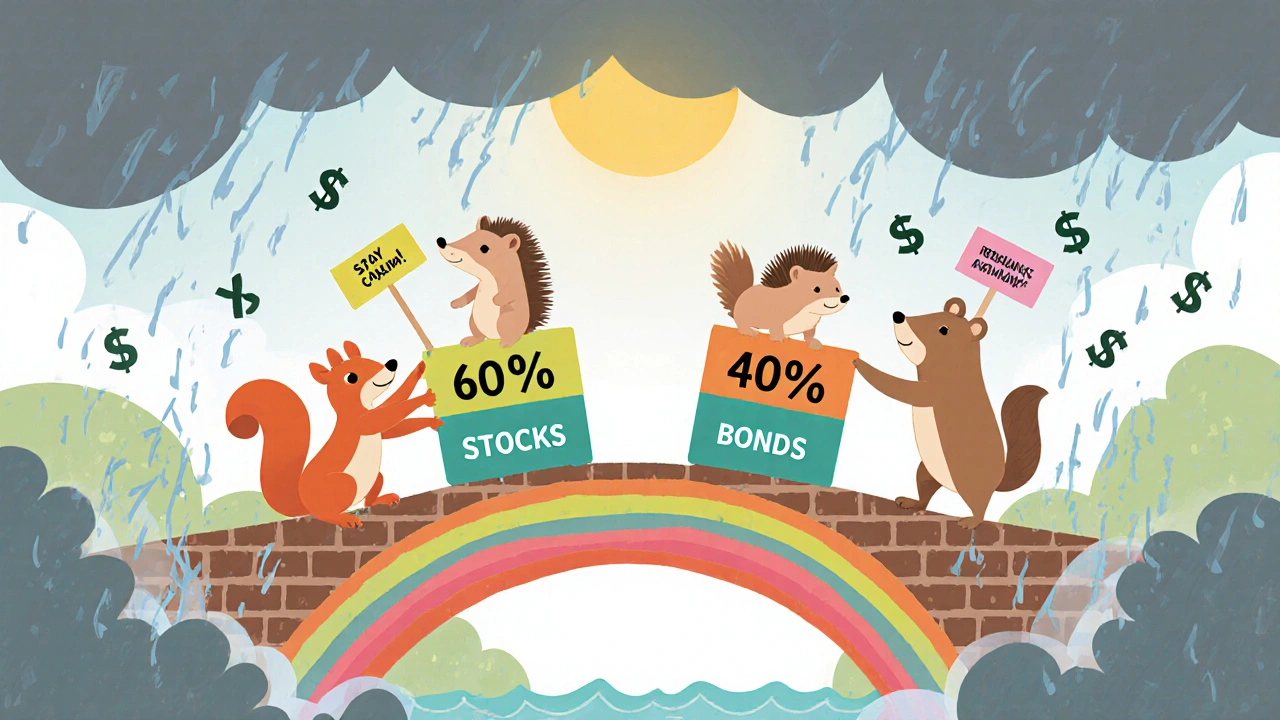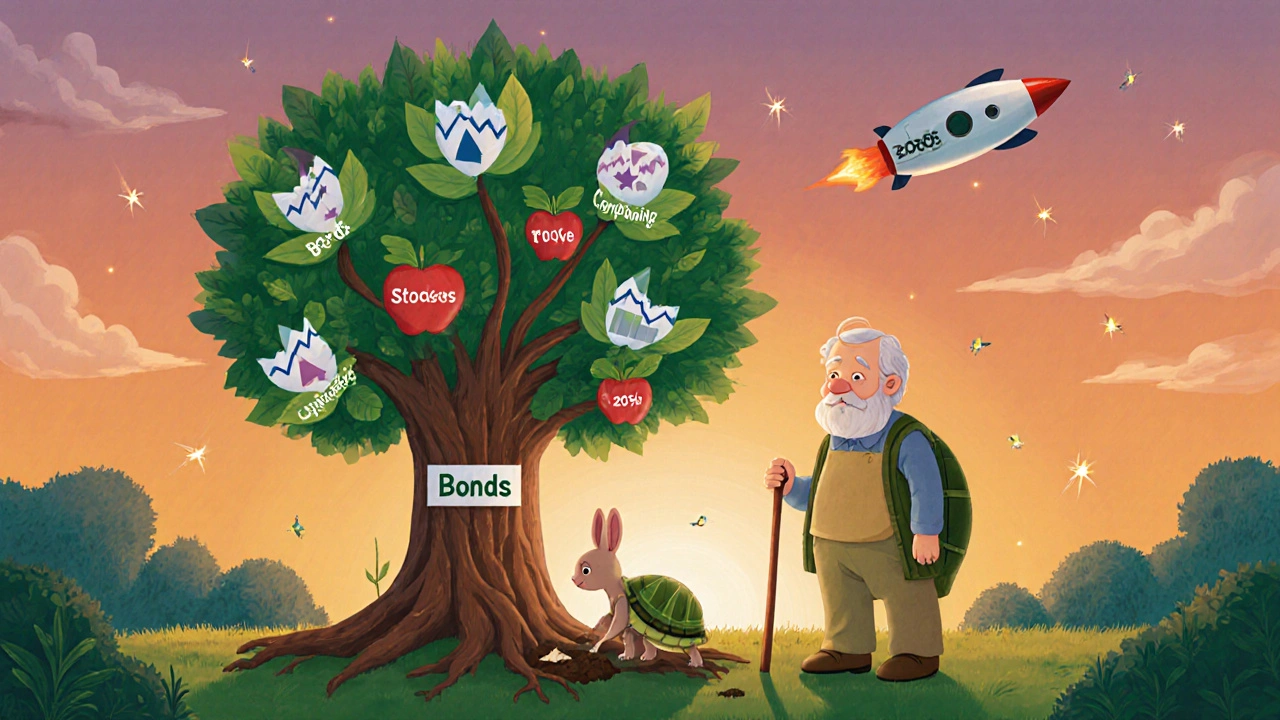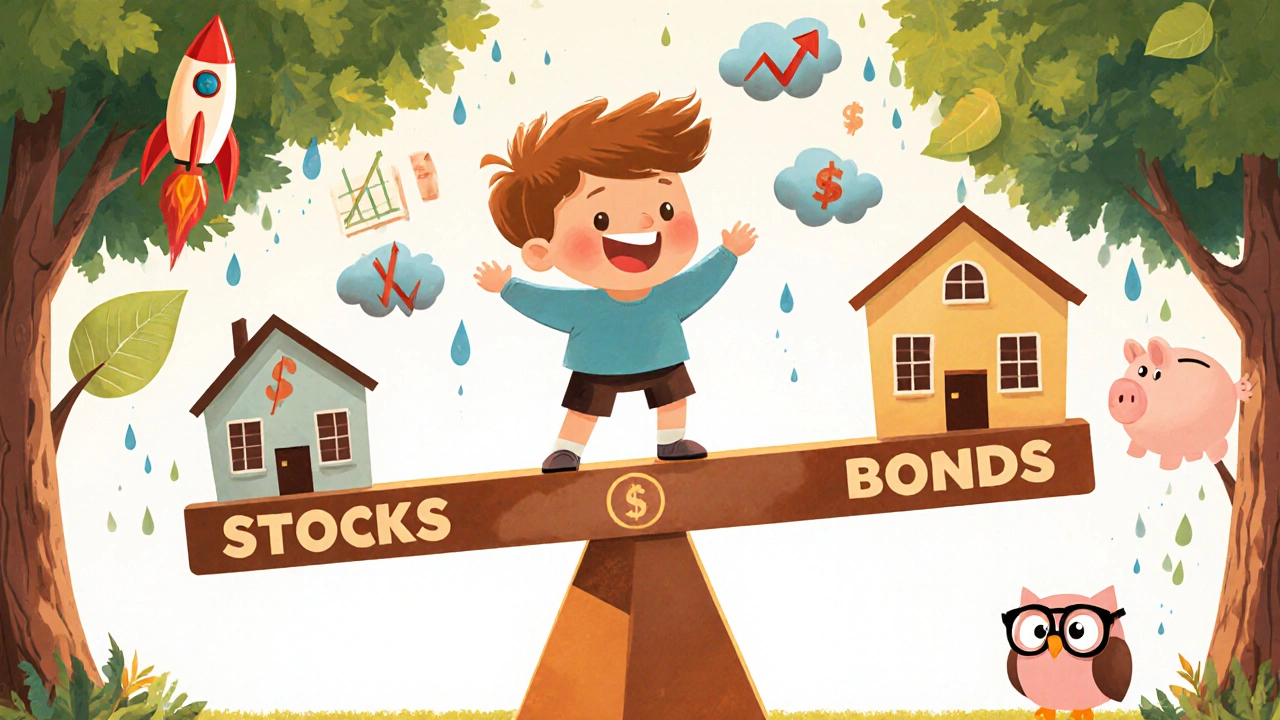Stocks-to-Bonds Allocation Calculator
Your Personalized Allocation Guide
Based on the article "Asset Allocation Strategy: How to Set Your Stocks-to-Bonds Ratio for Real Life", this calculator helps you determine the optimal balance for your portfolio based on your unique circumstances.
Your Information
Your Allocation Recommendation
-
-
Why This Allocation?
Your personalized recommendation based on your inputs. This is not financial advice but a starting point for your discussion with a professional.
Most people think investing is about picking the next hot stock or timing the market. But here’s the truth: your stocks-to-bonds ratio matters more than any single investment you’ll ever make. It’s the single biggest factor in how your portfolio performs over time - not your stock picks, not your timing, not your broker’s advice. Studies show it explains over 90% of your returns. That’s not a guess. That’s data from decades of research.
So why do so many investors ignore it? Because it feels boring. It doesn’t have the thrill of a 10-bagger. But here’s the thing: if you get this right, you don’t need to find the next Apple. You just need to stay invested, avoid panic selling, and let compounding do its job. And that’s exactly what a solid asset allocation strategy gives you.
What Your Stocks-to-Bonds Ratio Actually Does
Think of stocks as your growth engine. They’re volatile. They can drop 20% in a month. But over 10, 20, or 30 years, they’ve historically returned about 7-8% after inflation. Bonds? They’re your shock absorber. They don’t grow as fast - maybe 2-4% after inflation today - but they don’t crash the same way. When stocks fall, bonds often hold steady or even rise. That’s not magic. It’s math.
Putting money in both reduces your overall rollercoaster ride. T. Rowe Price found that a properly balanced portfolio can cut volatility by 20-40% compared to one stuffed with only stocks - while keeping 85-95% of the long-term growth. That’s huge. It means you’re less likely to bail out during a market dip, which is the #1 reason people lose money.
Forget the 100-Minus-Your-Age Rule (Seriously)
You’ve probably heard this: subtract your age from 100, and that’s your stock allocation. So a 40-year-old holds 60% stocks, 40% bonds. Simple. Easy. But it’s outdated.
People live longer. Retirements last 30 years now, not 15. Inflation doesn’t sleep. And bonds? Their yields are lower than they’ve been in decades. That’s why financial pros are moving to 110-minus-your-age or even 120-minus-your-age. A 40-year-old today might reasonably hold 70-80% in stocks, not 60%.
John Bogle’s original ‘age in bonds’ rule - put your age in bonds - was meant as a starting point, not a law. Vanguard’s Chief Investment Officer, Melissa Braun, said in 2022 that those old rules are “too conservative for today’s longer-lived investors.” If you’re 60 and retired, holding 60% bonds might sound safe. But if your money needs to last 30 more years, you’re probably underexposed to growth.
Real-World Allocation Models That Work
Here’s what actual institutions use - not theory, not blogs, but real portfolios managing billions.
- T. Rowe Price (2023): At retirement, they recommend 30-50% stocks, 40-60% bonds, and up to 10% cash. That’s not “play it safe.” That’s “stay ahead of inflation.”
- Vanguard’s Moderate Portfolio: 60% stocks, 40% bonds. This is the default for most target-date funds. It’s not flashy, but it’s been tested through multiple recessions.
- Charles Schwab: They group by risk, not age. Moderate investors (10-year horizon): 60% stocks, 35% bonds, 5% cash. Conservative? 20% stocks, 50% bonds, 30% cash. That’s for someone who might need cash in 3-5 years.
- Benjamin Graham’s 25-75% Rule: From his 1949 book, still holds up. Portfolios staying between 25% and 75% in stocks had positive real returns in 92% of all 20-year periods since 1926.
Notice something? No one says “100 minus your age.” They all look at time horizon, risk tolerance, and income needs. Your portfolio isn’t a math problem. It’s a life plan.

How to Find Your Number (Step by Step)
You don’t need a financial advisor to figure this out. Here’s how to do it yourself in 10 minutes.
- Ask yourself: When will you need this money? Are you 25 and saving for retirement in 40 years? Or 55 and planning to retire in 5? Time horizon is your starting point.
- How much can you handle when things crash? If your portfolio drops 30%, do you sleep fine? Or do you check your account every hour? If you panic, you need more bonds. If you can wait it out, you can take more stocks.
- What’s your income outside your portfolio? Do you have a pension? A steady job? A side business? If yes, you can afford more stocks. If your entire income depends on your investments, be more conservative.
- Look at the numbers above. Pick a range. If you’re 35, have no debt, a stable job, and plan to retire at 65, 80% stocks and 20% bonds is reasonable. If you’re 60, retired, and need to withdraw 4% a year, aim for 40-50% stocks, 40-50% bonds.
Don’t lock in forever. Revisit this every 1-2 years, or after a big life change - marriage, job loss, inheritance, kids going to college.
Why Most People Get This Wrong (And How to Avoid It)
The biggest mistake? Letting emotions drive your allocation.
Charles Schwab studied investors during the 2020 market crash. 68% of those who moved money out of stocks during the dip ended up underperforming those who stayed the course by 4.2% over the next year. Why? They bought high and sold low - the exact opposite of what they meant to do.
Here’s how to stop that:
- Set it and forget it - mostly. Pick your ratio. Stick to it. Don’t change it because the news is scary.
- Rebalance once a year. If stocks surge and your 60/40 split becomes 70/30, sell some stocks and buy bonds to get back to your target. This forces you to sell high and buy low - automatically.
- Use automatic rebalancing. Most brokerages (Fidelity, Vanguard, Schwab) offer this for 0.15-0.30% a year. It’s cheaper than a human advisor and removes emotion.
And if you’re overwhelmed? Use a target-date fund. It’s a single fund that automatically adjusts your stocks-to-bonds ratio as you get older. Vanguard’s Target Retirement 2050 Fund, for example, starts at 90% stocks and slowly shifts to 50% stocks by 2050. No thinking required.

What’s Changing Now (And What It Means for You)
Markets aren’t what they were. Bond yields are lower. Stock valuations are higher. Inflation is stickier. The old 60/40 portfolio isn’t delivering the same returns it used to.
J.P. Morgan’s 2023 forecast expects stocks to return 5.5-6.5% and bonds 2.5-3.5% over the next 10-15 years - well below historical averages. That means you might need to save a little more, or work a little longer, to hit your goals.
Some firms are adapting. BlackRock’s “Market-Aligned” framework adjusts bond allocations based on real-time interest rates, not age. Others are adding real estate or REITs as a “bond plus” - offering income and lower volatility than stocks.
And yes, the SEC now says crypto can be 1-5% of an aggressive portfolio. But don’t chase it. It’s not a replacement for bonds. It’s a speculative add-on. Stick to the basics unless you know exactly what you’re doing.
Final Rule: Your Allocation Should Feel Boring
The best asset allocation strategy isn’t the one that makes headlines. It’s the one you can stick with when everything’s falling apart.
It’s the one that lets you sleep at night. The one that doesn’t make you check your phone every hour. The one that lets you focus on your life - not your portfolio.
So don’t overthink it. Don’t chase the latest guru. Pick a ratio that fits your life. Stick to it. Rebalance when needed. And let time do the heavy lifting.
That’s not exciting. But it works.
What’s the best stocks-to-bonds ratio for a 30-year-old?
For a 30-year-old with a long time horizon and steady income, 80-90% stocks and 10-20% bonds is common. Some use 110 minus age (80% stocks), others go as high as 90%. The key is choosing a number you won’t abandon during a market crash. If you’d panic at a 30% drop, lean toward 70% stocks. If you’re comfortable riding out volatility, 85% is fine.
Should I increase bonds as I get older?
Yes - but not as much as you think. Traditional advice says shift to 60% bonds at 60. But with longer lifespans and lower bond yields, many now keep 40-50% stocks even in retirement. The goal isn’t safety - it’s growth that outpaces inflation over 20-30 years. If you’re retired and need income, bonds help. But if you need your money to last decades, you still need stocks.
Can I use cash instead of bonds?
Cash is fine for short-term needs - like an emergency fund or money you’ll need in 1-2 years. But for long-term portfolio stability, bonds are better. Cash earns almost nothing (0.5-1% today), while bonds offer income and tend to rise when stocks fall. Holding too much cash in your investment portfolio is like parking your car in neutral on a downhill slope - you’re not moving forward, and you’re at risk of falling behind inflation.
Do I need to rebalance my portfolio?
Yes. Markets move. If stocks surge, your 60/40 split might become 70/30. That means you’re now more exposed to risk than you intended. Rebalancing - selling some stocks and buying bonds - brings you back to your target. It’s not market timing. It’s discipline. Doing this once a year adds about 0.4% in annual returns over time by forcing you to sell high and buy low.
Are target-date funds a good option?
Yes - especially if you don’t want to manage your allocation. Target-date funds automatically adjust your stocks-to-bonds ratio as you near retirement. Vanguard, Fidelity, and T. Rowe Price offer them with low fees (as low as 0.08%). They’re simple, diversified, and remove emotional decisions. Just make sure you understand the fund’s final allocation - some still have 30% stocks at age 85, which is smart for longevity.




Been using 85/15 for my 30yo portfolio and honestly? Best decision ever. Didn't panic during '22 crash, just kept contributing. Bonds are boring but they let me sleep. 🤘
I love how this post cuts through the noise. So many people think investing is about chasing returns, but it’s really about staying in the game. I’m 48 and still at 70/30-my pension covers the basics, so I don’t need to be ultra-conservative. Rebalancing annually on autopilot via Vanguard has been a game-changer. No stress, no second-guessing. Just steady growth.
Also, cash as a substitute for bonds? Big no. I used to hold too much cash thinking it was ‘safe.’ Turned out I lost more to inflation than I ever lost in a market dip. Bonds aren’t sexy, but they’re the quiet hero of your portfolio.
THE 100-MINUS-YOUR-AGE RULE IS A LIE. I can’t believe people still follow this like it’s scripture. My dad did it-he was 65 with 35% stocks and died at 78 with his portfolio barely keeping up with inflation. He died broke in spirit. That’s not safety, that’s surrender.
Real talk: if you’re retired and holding 60% bonds in 2025, you’re not being cautious-you’re being lazy. Bond yields are garbage, inflation’s still breathing down your neck, and your 30-year retirement isn’t a fantasy-it’s a fact. You need growth. You need stocks. Period.
And target-date funds? Yes. But check the final allocation. Some of them still have 40% stocks at 85. That’s not reckless-that’s survival. If you’re not planning to outlive your money, you’re not planning at all.
Stop romanticizing safety. Safety without growth is a slow death. I’ve seen it. I’ve lived it. Don’t be that guy.
Also-crypto as 1-5%? Fine. But don’t confuse it with a bond substitute. That’s not diversification, that’s gambling with a fancy label. Stick to the boring stuff. It’s the only thing that actually works.